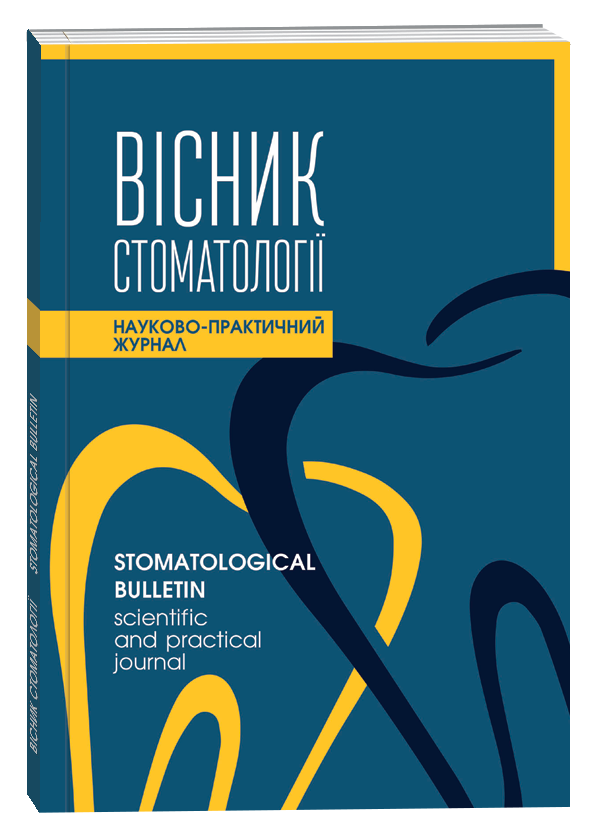CLINICAL AND ANATOMICAL FEATURES OF MAXILLARY FRACTURES IN PATIENTS WITH DIFFERENT TYPES OF ITS PNEUMATIZATION
DOI:
https://doi.org/10.35220/2078-8916-2021-39-1-36-47Keywords:
pneumatization index, FISS, maxillary frac-tures, midface bones, Le FortAbstract
The individual anatomy of the midfacial bones character-ize features of their fractures and complicates the process of treatment and rehabilitation of patients with traumatic injuries.
Aim. Study relationship between the clinical and radio-logical characteristics of maxillary fractures and the fea-tures of its structure, according to the degree of pneumatization.
Materials and methods. The values of the number of frac-ture lines, the number of fragments, the frequency of de-fect formation in the areas of buttresses, the Facial Injury Severity Scale in patients with different values of the pneumatization index (PI) were analyzed and compared.
Results. The pneumatic type of midfacial bones charac-terized by an increase in the degree of fragmentation and defect formation of the buttresses in comparison with the normal type (66 % and 58 %, respectively, p>0.999).
Conclusions. The characteristics of midfacial bones frac-ture depends on the peculiarities of its architectonics and PI, which must be taken into account when planning sur-gical treatment.
References
Ludi E.K., Rohatgi S., Zygmont M.E., Khosa F., Hanna T.N. Do Radiologists and Surgeons Speak the Same Language? A Retrospective Review of Facial Trauma. AJR Am J Roentgenol. 2016;207(5):1070-1076. doi: 10.2214/AJR.15.15901. Epub 2016 Aug 24. PMID: 27556232.
Regmi K.P., Tu J., Ge S., Hou C., Hu X,. Li S., Du J. Retrospective Clinical Study of Maxillary Sagittal Fractures: Predictors of Postoperative outcome, Journal of Oral and Maxillofacial Surgery. 2016:576-583 doi: 10.1016/j.joms.2016.11.012.
Lozada K, Kadakia S, Abraham MT, Ducic Y. Complications of Midface Fractures. Facial Plast Surg. 2017 Dec;33(6):557-561. doi: 10.1055/s-0037-1607447. Epub 2017 Dec 1. PMID: 29195235.
Malanchuk V.O., Kopchak A.V., Astapenko O.O., Shuminsky E.V. Doslidzhennya anatomichnoyi budovy ta arkhitektoniky kistok serednʹoyi zony oblychchya za danymy spiralʹnoyi komp’yuternoyi tomohrafiyi. Novyny stomatologii. 2016;№2(87):66-70. [in Ukrainian]
McRae M., Frodel J. Midface fractures. Facial Plast Surg. 2000;16(2):107-13. doi: 10.1055/s-2000-12572. PMID: 11802361.
Le Fort R. Experimental study of fractures of the upper jaw Parts I and II. Rev Chir Paris. 1901;23:208; translated by Tessier P, and reprinted in Plast Reconstr Surg 1972;50: 497
Bagheri S.C., Dierks E.J., Kademani D., Holmgren E., Bell R.B., Hommer L., Potter B.E. Application of a facial injury severity scale in craniomaxillofacial trauma. J Oral Maxillofac Surg. 2006 Mar;64(3):408-14. doi: 10.1016/j.joms.2005.11.013. PMID: 16487802
Marciani R.D. Management of midface fractures: fifty years later. J Oral Maxillofac Surg. 1993 Sep;51(9):960-8. doi: 10.1016/s0278-2391(10)80035-7. PMID: 8355101.
Kanda Y. Investigation of the freely available easy-to-use software ‘EZR’ for medical statistics. Bone Marrow Transplant. 2013;48:452–458.
Maddux S.D., Butaric L.N. Zygomaticomaxillary Morphology and Maxillary Sinus Form and Function: How Spatial Constraints Influence Pneumatization Patterns among Modern Humans. Anat Rec (Hoboken). 2017 Jan;300(1):209-225. doi: 10.1002/ar.23447. PMID: 28000407.
Hampson D. Facial injury: a review of biomechanical studies and test procedures for facial injury assessment. J Biomech. 1995 Jan;28(1):1-7. doi: 10.1016/0021-9290(95)80001-8. PMID: 7852433
Donat T.L., Endress C., Mathog R.H. Facial fracture classification according to skeletal support mechanisms. Arch Otolaryngol Head Neck Surg. 1998 Dec;124(12):1306-14. doi: 10.1001/archotol.124.12.1306. PMID: 9865751.
Sigaud S. Le forme humaine C. Sigaud. - Paris, 1914 (Tsytyruetsia no B.A Nykytiuk. Novosty sportyvnoi y medytsynskoi antropolohyy. Nauchno-ynformatsyonnыi sbornyk. M. 1991;2:5-7
Roumeliotis G., Ahluwalia R., Jenkyn T., Yazdani A. The Le Fort system revisited: Trauma velocity predicts the path of Le Fort I fractures through the lateral buttress. Plast Surg (Oakv). 2015 Spring;23(1):40-2. doi: 10.4172/plastic-surgery.1000899. PMID: 25821772; PMCID: PMC4364145.
Stanley R.B. Jr. Rigid fixation of fractures of the maxillary complex. Facial Plast Surg. 1990;7(3):176-84. doi: 10.1055/s-2008-1064680. PMID: 2135701.
Tanne K., Miyasaka J., Yamagata Y., Sachdeva R., Tsutsumi .S, Sakuda M. Three-dimensional model of the human craniofacial skeleton: method and preliminary results using finite element analysis. J Biomed Eng. 1988 May;10(3):246-52. doi: 10.1016/0141-5425(88)90006-4. PMID: 3392976.
Zannoni C., Mantovani R., Viceconti M. Material properties assignment to finite element models of bone structures: a new method. Med Eng Phys. 1998 Dec;20(10):735-40. doi: 10.1016/s1350-4533(98)00081-2. PMID: 10223642.









